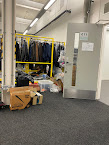Day 1:
I arrived at the studios at 10am, while the cast and crew were leaving to go to set. My contacts were through the producers, so I went to the production office and met the team. I was shown around the studios while the other departments finished up their morning. I was explained the organisation process with pre and ongoing production, as well as the shooting schedule and call sheets. I was able to speak to an editor going through the previous day's footage, who explained the software (Avid) and the director's instructions for him.

I then set up the lineup for the next day's scenes, as well as meeting the costume designer Lance Milligan (who also worked on Warp's Tyrannosaur (2011)) and organised some items for a later fitting.

Finally, I oversaw the catering for the department at lunch, as well as greeting and accommodating the actor Alex Pettyfer.
Due to the nature of the scenes shot, I wasn't able to travel to set, but I thoroughly enjoyed staying in the studios. I was able to talk to a lot of the crew, and learn about their work, as well as how they ended up working in the industry. I found it interesting to learn about some aspects of the industry I wasn't as aware of, and see the practical and organisational sides to the job.
Day 2:
I started my morning by going to the production office and speaking to two of the producers there. I was given a lot of advice by them, but specifically the importance of networking and having contacts to refer to. I then met the floor runners, and was travelled to set. I was able to watch everyone set up and the different technical details needed to shoot a scene. The producer Isen Robbins, spoke to me and explained the process and what each individual person or department was doing. I sat in the rehearsal, where an armorer was present to make sure everything was going well and there wouldn't be any mistakes. I found this specifically interesting as I could see the real industry consequences after the Alec Baldwin accident. I watched the shoot, and I was very interested by the communication between the DP and the director, as well as the actors.
When travelling to the second location, I was lucky to be seated next to the director Phil Allocco, who told me that the key to being a good director was being a good editor. He explained his experience and how he liked to work, as he also wrote the screenplay, and how he felt it was a collaborative process between the director and actors, rather than them just being instructed by him.
While the second location was being set up I had a chance to speak to the makeup department, security and the casting directors. There was another setback with having small children on set, and I was able to see the procedures for that as well. The rest of the day was quiet as it was a closed set due to small space, but I had a chance to speak to the floor runners who gave me the advice to keep working in the industry to build up connections parallel to building up my own portfolio. I was also told to start writing as it is much easier for a film to be picked up if the director has written it too.
I found today very interesting, but was shocked at the amount of waiting time on set. However, I used this as much as I could to speak to as many different crew members as I could. I was impressed by all the work and different roles going into it, that I wasn't aware of before.
Day 3:






No comments:
Post a Comment